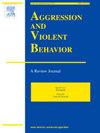儿童和青少年有害性行为的初级预防:系统回顾和叙述综合
IF 3.4
2区 心理学
Q1 CRIMINOLOGY & PENOLOGY
引用次数: 0
摘要
从公共卫生的角度来看,处理儿童有害性行为的战略往往侧重于二级或三级预防,而不是初级预防。预防工作通常也侧重于防止成年人受害;然而,儿童性侵的很大一部分是由其他儿童和年轻人实施的。我们系统地回顾了儿童和青少年有害性行为的一级预防策略的研究。我们检索了6个数据库,提取了与项目设置和重点、参与者人口统计、测量结果和项目成功相关的数据。我们按照SwiM指南(Popay et al., c2006)进行了叙述性综合,并对纳入的研究进行了个体质量评估。20项研究符合我们的纳入标准。初级预防策略通常在有小学/小学、初中和高中学生的学校实施。所有的项目都将有害的性行为纳入更广泛的虐待预防项目。项目效果好坏参半。有害性行为的初级预防通常是通过更广泛的性暴力预防方案来解决的。大约四分之三评估项目效果的研究发现,测量结果有所改善,包括一些行为结果。项目成功的重要因素是谁促成了这个项目,以及学生对学校联系的感觉。我们没有发现任何旨在减少网上有害性行为的评估。项目发展的重要新方向将是:(i)解决年幼儿童的需求,以及残疾、神经认知差异和性别或性多样化的青年;(二)介绍和强化性行为存在从健康到有害的连续统一体的概念,并提供明确的例子;注重预防犯罪和受害;(iv)提出支持安全环境的战略——在家庭、组织、社区和网上;(e)确定成功预防有害性行为的基本要素,并使预防项目与这些特征相一致。本文章由计算机程序翻译,如有差异,请以英文原文为准。
Primary prevention of harmful sexual behaviors by children and young people: A systematic review and narrative synthesis
From a public health perspective, strategies for addressing children's harmful sexual behaviors often focus on secondary or tertiary prevention rather than primary prevention. Prevention efforts have also typically focused on preventing victimization by adults; yet a high proportion of child sexual abuse is perpetrated by other children and young people. We systematically reviewed the research on primary prevention strategies for harmful sexual behaviors in children and young people. We searched 6 databases, extracted data relating to program setting and focus, participant demographics, outcomes measured, and program success., We conducted a narrative synthesis in line with the SwiM guidelines (Popay et al., c2006), and conducted individual quality assessments of the included studies. 20 studies met our inclusion criteria. Primary prevention strategies were typically implemented in schools with primary/elementary, middle, and high school aged students. All programs included harmful sexual behavior within broader abuse prevention programs. Program effects were mixed. Primary-level prevention of harmful sexual behavior is typically addressed through broader sexual violence prevention programs. Around three-quarters of studies evaluating program efficacy found improvements in the outcomes measured, including some behavioral outcomes. Important to program success was who facilitated the program, as well as students' feeling of school connections. We found no evaluations of programs aimed at reducing harmful sexual behavior perpetrated online. Important new directions in program development will be to: (i) address the needs of younger children, as well as youth with disabilities, neurocognitive differences, and who are gender or sexually diverse; (ii) introduce and reinforce the concept that sexual behaviors exist on a continuum from healthy to harmful, providing clear examples; (iii) focus on both preventing perpetration and victimization; (iv) address strategies to support safe environments—in homes, organizations, communities, and online; and (e) identify essential elements for successful harmful sexual behavior prevention and align prevention programs with these features.
求助全文
通过发布文献求助,成功后即可免费获取论文全文。
去求助
来源期刊

Aggression and Violent Behavior
Multiple-
CiteScore
7.50
自引率
4.30%
发文量
63
期刊介绍:
Aggression and Violent Behavior, A Review Journal is a multidisciplinary journal that publishes substantive and integrative reviews, as well as summary reports of innovative ongoing clinical research programs on a wide range of topics germane to the field of aggression and violent behavior. Papers encompass a large variety of issues, populations, and domains, including homicide (serial, spree, and mass murder: sexual homicide), sexual deviance and assault (rape, serial rape, child molestation, paraphilias), child and youth violence (firesetting, gang violence, juvenile sexual offending), family violence (child physical and sexual abuse, child neglect, incest, spouse and elder abuse), genetic predispositions, and the physiological basis of aggression.
 求助内容:
求助内容: 应助结果提醒方式:
应助结果提醒方式:


